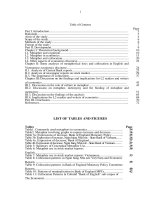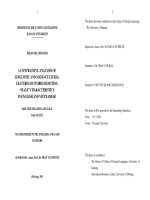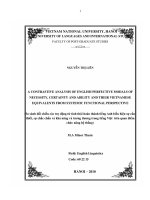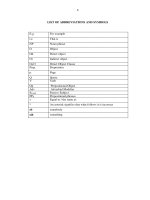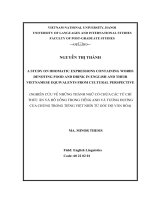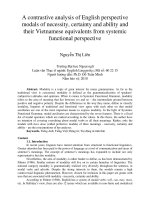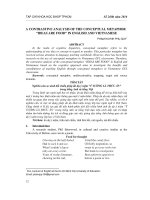A CONTRASTIVE ANALYSIS OF ENGLISH PERFECTIVE MODALS OF NECESSITY CERTAINTY AND ABILITY AND THEIR VIETNAMESE EQUIVALENTS FROM SYSTEMIC FUNCTIONAL PERSPECTIVE
Bạn đang xem bản rút gọn của tài liệu. Xem và tải ngay bản đầy đủ của tài liệu tại đây (752.03 KB, 54 trang )
1
VIETNAM NATIONAL UNIVERSITY, HANOI
UNIVERSITY OF LANGUAGES AND INTERNATIONAL STUDIES
FACULTY OF POST-GRADUATE STUDIES
A CONTRASTIVE ANALYSIS OF ENGLISH PERFECTIVE MODALS OF
NECESSITY, CERTAINTY AND ABILITY AND THEIR VIETNAMESE
EQUIVALENTS FROM SYSTEMIC FUNCTIONAL PERSPECTIVE
(
,
)
M.A Minor Thesis
Field: English Linguistics
Code: 60 22 15
HANOI 2010
2
VIETNAM NATIONAL UNIVERSITY, HANOI
UNIVERSITY OF LANGUAGES AND INTERNATIONAL STUDIES
FACULTY OF POST-GRADUATE STUDIES
A CONTRASTIVE ANALYSIS OF ENGLISH PERFECTIVE MODALS OF
NECESSITY, CERTAINTY AND ABILITY AND THEIR VIETNAMESE
EQUIVALENTS FROM SYSTEMIC FUNCTIONAL PERSPECTIVE
(
,
)
M.A Minor Thesis
Field: English Linguistics
Code: 60 22 15
Supervisor: (Ph.D.)
HANOI 2010
7
TABLE OF CONTENTS
Page
Declaration ……………………………………………………………………………
i
Acknowledgements …………………………………………………………………
ii
List of tables and figures ……………………………………………………………
iii
Abstract ……………………………………………………………………………….
iv
Table of contents ……………………………………………………………………
v
CHAPTER 1: INTRODUCTION …………………………………………………
1
1.1. Introduction ……………………………………………………………………….
1
1.2. Rationale for the Study ……………………………………………………………
1
1.3. Aims of the Study …………………………………………………………………
2
1.4. Scope of the Study ………………………………………………………………
3
1.5. Methodology of the Study ………………………………………………………
3
1.6. Design of the Study ……………………………………………………………….
3
CHAPTER 2: THEORETICAL ORIENTATIONS ……………………………….
5
2.1. Introduction ……………………………………………………………………….
5
2.2. Modality in English ……………………………………………………………….
5
2.2.1. The traditional view of Modality ………………………………………
5
2.2.1.1. The definition of Modality ………………………………… ….
5
2.2.1.2. Types of Modality ………………………………………………
6
2.2.1.3. Markers of Modality …………………………………………….
6
2.2.2. Modality in Functional Grammar ……………………………………….
6
2.2.2.1. Polarity and Modality …………………………………………
6
2.2.2.2. Types of modality ………………………………………………
7
2.2.2.3. Realizations of modality ………………………………………
9
8
2.2.2.4. Values …………………………………………………………
10
2.3. Modality in Vietnamese …………………………………………………………
10
2.3.1. Different viewpoints of modality in Vietnamese ……………………….
10
2.3.2. Types of modality ……………………………………………………….
11
2.3.3. Expressions of modality ………………………………………………
11
2.3.4. Features of Modality in Vietnamese ……………………………………
11
2.4. Modal verbs in English in the light of Systemic Functional Grammar …………
12
2.4.1. Definition of English modal verbs ……………………………………
12
2.4.2. Features of English modal verbs ………………………………………
13
2.4.3. List of modal verbs in English ………………………………………….
13
2.4.4. Modal verbs discussed in this study …………………………………….
14
2.5. Modal verbs in Vietnamese ……………………………………………………….
14
2.5.1. Definition of modal verbs in Vietnamese ………………………………
14
2.5.2. Features of modal verbs in Vietnamese ………………………………
15
2.5.3. List of modal verbs in Vietnamese ……………………………………
15
2.5.4. Modal verbs discussed in this study …………………………………….
16
2.5.5. Comparison of modal verbs in English and Vietnamese ……………….
16
2.6. Summary ………………………………………………………………………….
17
CHAPTER 3: ENGLISH PERFECTIVE MODALS OF NECESSITY,
CERTAINTY AND ABILITY FROM SYSTEMIC FUNCTIONAL
PERSPECTIVE AND THEIR VIETNAMESE EQUIVALENTS ………………
19
3.1. Introduction ……………………………………………………………………….
19
3.2. Perfective modals of necessity and their Vietnamese equivalents ………………
19
3.2.1. List of modals of necessity ……………………………………………
19
3.2.2. Scale of necessity ……………………………………………………….
21
3.2.3. Modals of necessity in the perfective …………………………………
23
3.2.3.1. Perfective modal verbs of necessity in the positive ………….
23
3.2.3.2. Perfective modals of necessity in the negative ……………….
24
9
3.2.4. Vietnamese equivalents …………………………………………………
25
3.2.4.1. Cần, cần pha
̉
i …………………………………………………
25
3.2.4.2. Phi …………………………………………………………
25
3.2.4.3. Khi …………………………………………………………
26
3.2.4.4. Nên …………………………………………………………
26
3.3. Perfective modals of certainty and their Vietnamese equivalents ………………
27
3.3.1. List of modals of certainty ……………………………………………
28
3.3.2. Scale of certainty ………………………………………………………
29
3.3.3. Modals of certainty in the perfective ……………………………………
31
3.3.3.1. Perfective modals of certainty in the positive ………………
31
3.3.3.2. Perfective modals of certainty in the negative ……………….
34
3.3.4. Vietnamese equivalents …………………………………………………
35
3.3.4.1. Khắc, phi …………………………………………………….
35
3.3.4.2. C th ………………………………………………………
36
3.3.4.3. Không thê
̉
…………………………………………………….
36
3.4. Perfective modals of ability and their Vietnamese equivalents …………………
36
3.4.1. List of English modals of ability ………………………………………
36
3.4.1.1. Can …………………………………………………………
36
3.4.1.2. Cannot ………………………………………………………
37
3.4.1.3. Could …………………………………………………………
37
3.4.1.4. Could not ……………………………………………………
37
3.4.2. Modals of ability in the perfective …………………………………
37
3.4.2.1. Could have ……………………………………………………
37
3.4.2.1. Couldn’t have ………………………………………………
38
3.4.3. Vietnamese equivalents …………………………………………………
38
3.4.3.1. C th ………………………………………………………
38
3.4.3.2. Không thê
̉
…………………………………………………
39
3.5. Summary …………………………………………………………………………
39
CHAPTER 4: CONCLUSION ………………………………………………………
41
10
4.1. Summary of the study …………………………………………………………….
41
4.2. Problems of teaching and learning English perfective modal verbs ……………
42
4.3. Some suggestions for teaching and learning …………………………………
43
4.4. Suggestions for further research …………………………………………………
44
REFERENCES ……………………………….………………………………………
45
5
LIST OF TABLES AND FIGURES
TABLES AND FIGURES
Page
Table 1:
Modalization and modulation (Halliday 1994: 91) …………………
8
Table 2:
Modality value (Halliday 1994: 360) …………………………………
10
Table 3:
Modal operators ………………………………………………………
14
Table 4:
Modal verbs in English and Vietnamese in the negative ……………
17
Table 5:
Three “values” of modality …………………………………………
21
Table 6:
Examples of requirement ……………………………………………
21
Table 7:
Examples of modal verbs of necessity with the values ………………
22
Table 8:
Summary of modals of necessity in the scale (Lock 1996: 213) ……
22
Table 9:
Deductions and predictions …………………………………………
28
Table 10:
Examples of likelihood ……………………………………………….
30
Table 11:
Examples of modal verbs of certainty with the values ………………
30
Table 12:
Summary of modals of certainty in the scale (Lock 1996: 213) ……
31
Table 13:
Summary of modal verbs of necessity, certainty and ability …………
40
Figure 1:
Probability and obligation with positive and negative propositions and
proposals ………………………………………………………….
20
Figure 2:
Modal values ………………………………………………………….
22
Figure 3:
Modal operators of certainty ………………………………………….
29
Figure 4:
Modal values ………………………………………………………….
30
11
CHAPTER 1: INTRODUCTION
1.1. INTRODUCTION
In recent years, linguists have turned attention from structural to functional linguistics.
Greater attention has been paid to the power of language as a tool of communication and areas
memeanings has expanded to include not only
representative but also modality.
Nevertheless, the area of modality is rather harder to define, as has been demonstrated by
Palmer (1986). Similar notions of modality still live on in certain branches of linguistics. The
notional category modality is grammatically realized very diversely throughout the sentence, in
modal verbs and adverbs. Despite the strong interests in them, the modals remain a high
controversial linguistic phenomenon. However, chosen for inclusion in this paper are grams with
uses that are associated with modality - necessity, certainty and ability.
According to Palmer (1986), English has a system of modal verbs: will, can, may,
must which are available in non-finite and
modalized verbal groups. We have past realized by (secondary) have (in a non-finite form)
Modal auxiliary verbs may sound easy at first but in fact, they are difficult. Making
this explicit to teachers and learners could reduce the teaching and learning burden. Hence, a
crucial requirement is the necessity to analyse perfective modals of necessity, certainty and
ability in sufficient depth. That is my preoccupation in writing this paper.
1.2. RATIONALE FOR THE STUDY
Of all the languages in the world today, English deserves to be regarded as a world
be
precision by learning how to use a verb. It is, therefore, necessary to acquire a thorough
knowledge of verbs, among which the English modals seem to be used at high frequencies.
Thanks to modal verbs, the communication among people can be diversified and colourful
12
because they can bring emotions, attitudes or opinions into what they say by using modals.
In fact, modal verbs are not simple as thought. They may be considered to be easy for the
beginners who just know the meanings superficially. However, when we can command the
language better, we find it really difficult to use their distinctive features properly.
English modal auxiliaries have captured my attention since I was a university student.
At that time, the fact that the more frequently modals are used, the more errors are made urged
perfective modals of necessity, certainty and a
Graduation Paper was discussed taking the view of traditional grammar. As a part of M.A.
program, I had chance to study Functional Grammar, which caused a number of troubles for
me in the beginning but caught my fancy at the end. After this course, the topic for my thesis
arose. That is analyzing perfective modals of necessity, certainty and ability using Systemic
Functional Grammar as the theoretical framework.
Reviewing the literature, quite a lot of questions concern modality and modals but
few of them have yet been definitely answered. Several researchers and learners have made
studies of modality and modals in general rather than perfective modals. My paper does not
yet offer a complete and coherent picture but it reflects, in my opinion, some of the best
efforts in that direction.
All the three reasons mentioned above are my motivations to carry out this study.
1.3. AIMS OF THE STUDY
It is my aim to focus on making some preliminary enquiries about modality and
modal verbs in English and Vietnamese. However, neither is my ambition to cover all the
things related to modality nor do I intend to deal with all aspects relating to each modal.
In view of the complexity of my subject matter, I will have to be eclectic and illustrate
the perfective modals of the three meanings of necessity, certainty and ability in the
spirit of functional grammar view in detail followed by their Vietnamese equivalents.
Bearing these aims and objectives in mind, I made every attempt to answer the following
research questions:
13
1. What is modality and how modality conceptualized in traditional grammar and in
Systemic Functional Grammar?
2. What are the modal verbs in English as seen from the light of Systemic Functional
Grammar and their Vietnamese equivalents?
3. How is modality of necessity, certainty and ability expressed by perfective modal
verbs and their equivalents in Vietnamese?
1.4. SCOPE OF THE STUDY
Studying all things about modality and modal verbs will be too broad themes and,
therefore, an impossible task for any researchers. For the feasibility of a minor M.A. thesis, I
narrowed the scope of my paper. Some preliminaries of modality and modal verbs are included
in the second chapter. Modality in English is not discussed in any branch of grammar apart from
in Traditional Grammar as the background and in the light of Functional Grammar as the focus.
An overview grasp of modality in Vietnamese is also mentioned in contrast. In the main chapter,
Chapter 3, I did not intend to investigate all the meanings of the modal auxiliaries. Rather, only
three meanings - necessity, certainty and ability were the concentration of my analyses. I did
not study these modals in general or simple modals but the modals with have done (called
perfective modals). My concern in the contrastive part was to find the equivalents in Vietnamese
for those modals in English.
1.5. METHODOLOGY OF THE STUDY
The methodology of the study was based on descriptive analysis and qualitative data
activities. The reference materials, after being collected or accessed, were selected, analyzed
and grouped into categories so that the subject can be described in detailed. Examples, tables
and figures were also provided to illustrate the description. For comparison, the writer
applies comparison of modal verbs expressing similar meanings in some examples in
English and Vietnamese.
1.6. DESIGN OF THE STUDY
This study comprises four chapters: Introduction, Theoretical orientations, English
Perfective modals of necessity, certainty and ability from systemic functional perspective and
their Vietnamese equivalents, and Conclusion.
14
The first chapter introduces, gives reasons, states what the study is aimed at,
identifies the delimitation of the study, presents the methodology and the organization of
the study.
Chapter 2 is mainly devoted to the theoretical dimensions of investigation, in which
modality and modals in English and Vietnamese are studied. This includes two main parts:
Modality in English and Vietnamese and Modal verbs in English and Vietnamese.
Chapter 3 is concerned with descriptions and analyses of the three meanings - necessity,
certainty and ability in English and Vietnamese equivalents.
The last chapter closes, briefly, with the summary, the discussion of the problems in
teaching and learning these modals and some suggestions for further research.
15
CHAPTER 2: THEORETICAL ORIENTATIONS
2.1. INTRODUCTION
The area of meaning referred to as modality is rather broad and finds expression in many
areas of the language besides mood. Different linguists use different terms in talking about
Mood and Modality, reminds us that different languages draw
on different features of their systems in order to present modality. I begin this chapter, therefore,
with a brief account of the central area covered by modality in English and Vietnamese.
Modality as grammatical categories is represented in Functional Grammar by operators at the
different levels of underlying structure of the clause. The result from Palmer (1986:1) is that
English actually has a system of modal verbs: will, can, may, must, etc. In describing the
meanings and uses of the modal auxiliaries, we will make distinctions among three meanings,
which I refer to as necessity, certainty and ability.
In this chapter, the preliminaries of modality in English and Vietnamese are treated in
the sections 2.2 and 2.3, while sections 2.4 and 2.5 deals with modal verbs in English and
Vietnamese. Section 2.6, finally, summarizes all the things discussed in the chapter.
2.2. MODALITY IN ENGLISH
Modality in this part will be seen from the lights of traditional grammar and Systemic
Functional Grammar.
2.2.1. The traditional view of Modality
As far as the traditional view of modality is concerned, the definition, types and
markers of modality will be presented.
2.2.1.1. The definition of Modality
In much of current linguistics, two concepts of modality are common. First, modality
can be defined more broadly as
(Fillmore 1968: 24). However, this definition is, in my view, far too broad to be of any real
interest. It would, as I see it, be more rewarding to apply a narrower definition of modality.
The second is modality as a grammatical category on a par with other grammatical categories
such as tense, aspect, or voice.
16
Though it is much vague and leaves open a number of possible definitions, the
speaker seems promising.
2.2.1.2. Types of Modality
emic, deontic, comissive, volitive and evaluative
modalities, the last, which is not strictly modal but semantically rather closely related.
Epistemic modality concerns language as information. It is the expression of the degree or
commitment to the truth of what he says (Palmer 1986: 121).
Deontic modality concerns language as action. It is mostly an expression by the
speaker of his attitude towards possible actions by himself and others (Palmer 1986: 121).
cited in Palmer 1986: 115).
Volitives are expressions of wishing and hoping (Palmer 1986: 116), and evaluatives
are expressions of attitudes towards known facts (Palmer 1986: 119).
2.2.1.3. Markers of Modality
Various types of modality listed above are expressed or realized by markers of
modality.
er these are grammatical or not can only
be decided in terms of the degree to which they have syntactic restrictions and the extent to
which they can be defined as a limited rather than open-ended system of items.
2.2.2. Modality in Functional Grammar
When it comes to modality in Systemic Functional Grammar, four other respects that
should be taken into account from our viewpoint are polarity and modality, types of modality,
realizations of modality and values.
2.2.2.1. Polarity and Modality
Polarity is included in this chapter because it is treated, in some accounts, as related
to modality.
17
Halliday talks about polarity as the choice between positive and negative, as in ,
. Meanwhile, modality refers to the area of meaning that lies between yes and no the
intermediate ground between positive and negative polarity (1994: 356).
Polarity is seen in terms of the end-points of the scales of probability, usuality,
obligation and inclination. Halliday (1994: 90) distinguishes between two types of negative
polarity: one is realized as or unstressed not as part of Finite element of the clause, the
other, realized by phonologically salient not, is analyzed as a separate modal Adjunct.
In accordance with Lock (1996: 193), it is possible to define modality both broadly and
narrowly. A broad definition would encompass all expressions of interpersonal meanings that
lie between it is so and it is not so or between do it and . A narrow definition of
modality encompasses only the modal auxiliaries and their uses, and sometimes also adverbs
functioning as modal adjuncts, such as possibly, probably and certainly. This chapter will take
a fairly narrow view of modality:
“Modality is the speaker’s assessment of the probabilities inherent in the
situation; or, in a derived sense, of the rights and duties” (Halliday and
Hasan 1976:135).
2.2.2.2. Types of modality
Like differences in the way they define modality, functional grammarians, in their
writings, mention numerous ways to classify modality. Dik distinguishes between different
types of modality on the basis of the subdivisions proposed by Hengeveld (1987, 1989), who
drew heavily on the insights of Lyons (1977) and Foley and Van Valin (1984) in particular
(cited in Anna 1991: 123). He, then, divides the semantic distinctions typically subsumed
epistemological modality.
between a participant in the state of affair (SoA) and the realization of that SoA. The types of
modal distinctions conveyed by inherent modality include ability, willingness, obligation,
permissibility and volition.
Objective modality is characterized in Functional Grammar as involving the evaluation of
18
The term epistemological modality is proposed by Hengeveld (1987) to cover
subjective modalities and evidentials.
According to Geoff Thompson (1996: 57), if the commodity being exchanged is
information, the modality relates to how valid the information in terms of probability (how
likely it is to be true) or usuality (how frequent it is true). In order to distinguish these two
basic types of modality, the first is called modalization (or epistemic modality), whereas the
second is referred to as modulation (or deontic modality). The sub-categories of the former are
probability and usuality while those of the latter are obligation and inclination. These types
are summarized in the following table:
Table 1: Modalization and modulation (Halliday 1994: 91)
Halliday then
that of ability / potentiality
commodity
exchange
speech function
type of intermediacy
typical
realization
example
information
proposition:
statement,
question
modalization:
probability
(possible
/probable
/certain)
finite modal
operator
modal Adjunct
(both the
above)
they must have known
they certainly knew
they certainty must
have known
usuality
(sometimes
/usually
/always)
finite modal
operator
modal Adjunct
(both the above)
it must happen
it always happens
it must always happens
goods-&-
services
proposal:
command
modulation:
obligation
(allowed
/supposed
/required)
finite modal
operator
passive verb
Predicator
you must be patient
patient
offer
inclination
(willing
/keen
/determined)
finite modal
operator
adjective
Predicator
I must win!
19
2.2.2.3. Realizations of modality
Modality covers a broad area and can be expressed by many forms. Downing and
Locke (1992: 383, 384) observe that they may be divided into two main groups: the verbal and
the non-verbal exponents.
Verbs expressing modal meanings include the following:
(i) Lexical verbs such as allow, beg, command, forbid, guarantee, guess, promise,
suggest, warn, etc.
(ii) The verbs wonder and wish, which express doubt and wish, respectively.
(iii) The lexico-modal auxiliaries composed of be or have, usually another element +
infinitive (have got to, be bound to, etc.)
(iv) The modal auxiliaries can, could, will, would, must, shall, should, may, might,
ought, and the semi-modals need and dare.
Other means are also suggested to express modalities:
(i) Modal disjuncts such as probably, possibly, surely, hopefully, thankfully, obviously.
(ii) Modal adjectives such as possible, probable, likely used in personal constructions
such as or as part of a Nominal Group, as in a likely winner of this
or the most probable outcome of this trial.
(iii) Modal nouns such as possibility, probability, chance, likelihood as in
a chance that he may come.
(iv) Certain uses of if-clauses as in if you know what
?
(v) The use of the remote past as in .
(vi) The use of non-assertive items such as any as in d of vegetable.
(vii) Certain types of intonation, such as fall-rise.
(viii) The use of hesitation phenomena in speech.
It is clear from Downing and Lo a variety of means of
expressing modality. In this paper, we will adopt a very limited scope, taking modal
auxiliaries to be basically the expression of necessity, certainty and ability.
20
2.2.2.4. Values
In Systemic Functional Grammar, discussing any type or any realization of modality
will not be enough without taking values into account. Admittedly, language differs not only
in the number and the kinds of the layer values but also in the means by which these values are
expressed. Some languages use grammatical means; others use lexical ones. We talk about
modality as involving degrees and scales. Functional structure is different in the way that it
consists of attributes that are specified particular values. As Thompson (1996: 59) realizes, the
It is possible to formalize this to some extent and to establish three basic values
(Halliday 1994: 358) or point on the scale: high, median and low, which he considers to be the
third variable in modality. The system of values has the primary option between the median
and outer values. Within the latter, there is also a contrast between the lower value and the
higher value. With the median, the negative is freely transferable between the proposition and
the modality, whereas, with the outer values, if the negative is transferred, the value switches
(either from high to low, or from low to high). The following table is the presentation of
modality values:
median
VALUE high
outer low
Table 2: Modality value (Halliday 1994: 360)
2.3. MODALITY IN VIETNAMESE
2.3.1. Different viewpoints of modality in Vietnamese
In Vietnamese, different writers hold different viewpoints of modality. The broad
conception of mo
, writings, epecially in Cao
and many followers (, ,
).
(1991: 98) builds up the definition of modality from the relation with
theme-rheme. He considers modality of an utterance as the attitude of the speaker towards
21
2.3.2. Types of modality
Of different viewpoints of modality in Vietnamese ,
relatively clear and detailed as follows: When studying Vietnamese sentences, he claims that it
2.3.3. Expressions of modality
There are a variety of means expressing modality in Vietnamese. However, in non-
inflected languages like Vietnamese, the distinction between lexicology and grammar means
in expressing modality is not strictly discussed (
1998: 221).
In order to express modal meanings , the following means ,
Liên (1999: 89-95), can be used:
(i) Using word order (
)
(ii) Using intonation (
)
(iii) Using modality particles ( ): , , , , , nghen, ,
, , nha, ,
,
, ,
(iv) Using modality complex (
):
, ,
, ôi! , ,
(v) Using adjuncts ():
,
(vi) Using adverbs (
):
,
, , m,
,
, ,
(vii) Using affixes ()
2.3.4. Features of modality in Vietnamese
In spite of a large number of people involved in studying modality, no detailed list of
features of modality in Vietnamese has been proposed. From the discussion of the eight expressions:
(1)
(2)
(3)
(4)
22
(5)
(6)
(7)
(8)
of a separate clause, the theme, the rheme or a minor clause (2006: 323,324). Here, it can be
seen that the eight expressions with different ways of using words, phrases and structures
bringing different meanings. Of them, the (1) and (8) expressions show the highest degree of
certainty and the (6) shows the lowest.
In Vietnamese, we have the two choices of value to express modality, either certainty
or possibility. If something is considered certain, then it is distinguished from possible and
vice versa.
Apart from the above, other systems of modality in Vietnamese are frequency, which
can be realized by both verbal and non-verbal forms like ;
polarity, which is represented by words like ; and consequence, which
can be realized not only by verbal forms but also by non-verbal forms such as
.
2.4. MODAL VERBS IN ENGLISH IN THE LIGHT OF SYSTEMIC
FUNCTIONAL GRAMMAR
In what follows we will be concerned with the modal verbs in English as seen from the
light of Systemic Functional Grammar. We now will present a brief characterization of the
modals; and then the three specific meanings necessity, certainty and ability will be taken
up in the following chapter.
2.4.1. Definition of English modal verbs
A great number of books have been written about English modal verbs, modal
auxiliaries, modal operators or shortly called modals. In his major study of English, Halliday
(2005: 170) makes the claim that modality is expressed by either or both of two elements, one
verbal and the other non-
The verbal forms are the modal auxiliaries.
23
In order to answer the question what modal auxiliary verbs are, Swan (2005: 353)
states that modal auxiliary verbs are used before the infinitives of other verbs, and add certain
kinds of meaning connecting with certainty, or with obligation and freedom to act.
To be easier to follow, in this paper we will follow the definition suggested by
Down
2.4.2. Features of English modal verbs
The modal auxiliaries are characterized by the following seven features presented by
Halliday (2005: 170):
(i) They have only finite forms: there is no *to can, canning.
(ii) They form negative and interrogative without expansion, the negative also being
reducible: not ?
yes I can; so can I.
(iv) They have three prosodic values, remiss (unstressed), ictus (secondary stress)
and tonic (primary stress): // ^ he can / go //, // ^ he / can / go //, // ^ he / can / go //, the
unstressed form being normally reduced; these are systemic variants, differing on meaning
in a regular way.
They are further distinguished from the other verbal auxiliaries be, get, have and do by
the fact that:
(v) They do not take s on the third person singular: he can not *he cans.
Finally
(vi) They do not occur in imperative.
(vii) They do not combine with each other.
2.4.3. List of modal verbs in English
Freddi observed that there are various resources in the lexico-grammatical repertoire of
English that a speaker can choose from to express modal meanings. Epistemic modality or
modalization and deontic modality or modulation can be expressed by finite modal operators
like will, would, may, might, can, could, shall, should, must, ought to and semi-modals like
need, dare, have to and used to. (p. 96, 97)
24
, the set of central modals in English is fairly well
defined: it includes the items can, could, may, might, will, would, shall, should, must.
According to Halliday & Hasan (1976: 180), a modality is expressed either or both of
two elements, one verbal and the other non-verbal. The verbal forms are the modal auxiliaries
or the modal operators:
(i) shall, will, should, would, can, could, may, might, must, ought (to)
(ii) am to, is to, are to, was to, were to [i.e. finite forms of be, plus to]
(iii) need, dare (in one use)
2.4.4. Modal verbs discussed in this study
Of various lists of modal verbs in English stated in 2.4.3, we follow Halliday (1994:
low
median
high
positive
can, may, could, might,
(dare)
will, would, should, is/was
to
must, ought to, need, has/ had
to
negative
+ need to, have to
Table 3: Modal operators
As can be seen from the table, he gives the different modal operators according to the
different values: high, median and low. Not all the modals listed above will be discussed in
this study. Only those being used in the perfective to express necessity, certainty and ability
will be the focus, instead.
2.5. MODAL VERBS IN VIETNAMESE
2.5.1. Definition of modal verbs in Vietnamese
In general, many different grammar documents discussing modal verbs in Vietnamese
have the following two points in common: First, modal auxiliary verbs are regarded as those
being used to combine
reality. Only in the specific context, can we leave the main verb associated with it . Typical for
, ,
,
. The second
25
view considers modal verbs to be those indicating the relation between the subject and the
verb standing after the modal.
.
2.5.2. Features of modal verbs in Vietnamese
(1977: 165) calls the verbs that do not indicate actions or states but
show ability, necessity or volition modal verbs. Their three main features are shown as follows:
(i) Like in English, modal verbs in Vietnamese are not often used alone. Instead, they
are used in combination with other verbs constituting a complex group, which plays the role of
the predicate.
(ii) Only in certain cases, mainly clear and evident linguistic context, can modal verbs
be used without other main verbs.
(iii) However, unlike in English, Vietnamese modal verbs can go with adverbs of
degree: .
Apart from the above persuasive opinion ,
(1998: 67, 68) are also necessary to be noted. First, modal verbs, like other dependent verbs,
can come before nouns: phải
được
(Nam Cao). Second, they can go before S-V: Chúng tôi cần các anh giúp cho m
.
2.5.3. List of modal verbs in Vietnamese
In what follows, . Firstly,
, etc. (p.217)
Secondly,
, etc. (2002: 195).
p Quang Ban (1998: 65, 66), moreover, divides these modal verbs into the
following subgroups. Initially, modal verbs showing necessity and ability consist of
Subsequently, modal verbs expressing will, wish or
26
desire include Last, modal verbs
indicating withstanding comprise
2.5.4. Modal verbs discussed in this study
As can be seen from the lists in the previous part, different grammarians have different
lists of modals in Vietnamese. Though having some differences in their lists, they agree with
each other that (need), (bear), (can),
(cannot), (must), nên
(intend), (want), ,
(have the heart to force ), ,
(be+ past participle with beneficial meaning), etc. are modal verbs. These will be the
modal verbs in Vietnamese discussed in this study.
2.5.5. Comparison of modal verbs in English and Vietnamese
As far as number is concerned ,
(2000: 217-219) finds that there are
25 modal verbs in English like may, could, can, could, will, need, be able to, etc. and 22 in
Vietnamese like , , ,
, , d,
, etc.
In terms of structure, in the positive, the essential similarity is that modal verbs in the
two languages have to be combined with the main verb to avoid being meaningless.
(9) On Sunday, we could stay up late.
(10) phải
.
We have the same formula: S + modal verb + main verb
Like in English, only in specific cases, especially in determined linguistic context,
Vietnamese modal verbs can stand alone playing the role of the predicate.
(11) Could you help me with this math problem? - Yes, I could.
(12) ? muô
́
n.
However, between modal verbs in English and Vietnamese, there exist some
differences in syntax features. Basically, modal verbs in Vietnamese can associate with
adverbs of degree: , , , etc. but most modal verbs in English cannot:
We cannot say *I should leave now very much. Modal verbs in English and in Vietnamese can
be combined with other types of adverbs:
(13) cng nên
, .
(14) You ought always to check your facts when you write essays.
27
Vietnamese in the negative:
English
S + modal
S + semi--modal + main verb
Vietnamese
S + không ()
() + modal verb + main verb
()
S +
i
Table 4: Modal verbs in English and in Vietnamese in the negative
From the comparison above, we can see that Vietnamese language has more ways to
create negative forms than in English, because Vietnamese has words (especially markers) to
express grammatical meanings.
In the interrogative, English questions can be formed using modal operators: Can
Aristotle lift 1,500 pounds? In Vietnamese, we cannot change the order of words in
sentences to make questions. Instead, we use the words like , ,
,
, at the end
of the sentence.
2.6. SUMMARY
This chapter has tried to study basic theory of modality and modal verbs in English and
Vietnamese. Modality in English was discussed from the two views: the traditional and
functional o
volitive and evaluative modalities. Also has been shown, three types of markers of modality
are individual suffixes, clitics and particles, and modal verb. In the light of Functional
Grammar, modality was studied in relation to polarity. Functional grammarians distinguished
two basic types of modality: modalization and modulation. The discussion also revealed three
basic values (high, median and low) on the scale.
28
Modality is also studied by quite a lot of the authors in Vietnam .
modality in Vietnamese (word order, intonation, particles, modality complex, adjuncts,
adverbs, and affixes ).
Among various viewpoints, English modal verbs can be understood as operators that
tial event indicated by the infinitive. A modal
auxiliary has the seven features presented by Halliday. Although there are a variety of lists of
modal verbs, we choose to study in this paper are the different modal operators within each of
the values - high, median and low - as suggested by Halliday:
high: must ought to need has to is to
median: will would shall should
low: may might can could
Like in English, Vietnamese modal verbs are used to
wishes towards the reality. Modal verbs in Vietnamese are also called dependent verbs. The
list of modal verbs include , , ,
, , nên, toan,
, , ,
toan,
, ,
, etc.
Finally, the comparison between modals in English and Vietnamese in terms of
number and structure (in the positive, negative and interrogative) were discussed.
